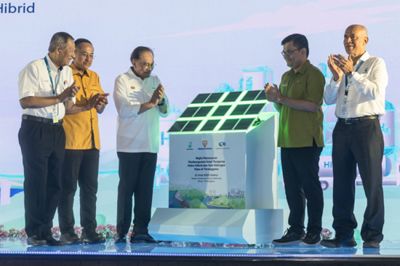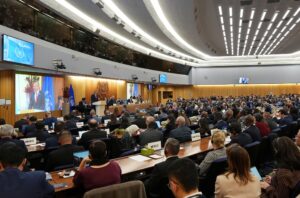Malaysia Launches Hybrid Hydro Solar and Green Hydrogen Hub in Terengganu

Terengganu, The Gulf Observer: Prime Minister Datuk Seri Anwar Ibrahim officiated the launch of the Hybrid Hydro Floating Solar (HHFS) and Green Hydrogen Hub projects in Kenyir, Terengganu, on Saturday, highlighting their strategic significance in advancing Malaysia’s clean energy agenda and attracting regional and international investment.
Speaking at the launch ceremony held at the Sultan Mahmud Power Station, the Prime Minister described the initiatives as a timely and efficient collaboration between Petroliam Nasional Berhad (PETRONAS) and Tenaga Nasional Berhad (TNB), in alignment with Malaysia’s energy policy and global green energy aspirations.
“Kenyir is now becoming a focal point of interest for international investors. This is not just a boost for Terengganu, but Kenyir itself will become a major attraction,” Anwar stated. “The project has also been implemented efficiently and swiftly.”
The event was attended by Deputy Minister of Energy Transition and Water Transformation Akmal Nasrullah Mohd Nasir, Terengganu Menteri Besar Datuk Seri Dr Ahmad Samsuri Mokhtar, TNB Chairman Tan Sri Abdul Razak Abdul Majid, and PETRONAS Chairman Tan Sri Mohd Bakke Salleh.
The HHFS and Green Hydrogen Hub initiatives are key to positioning Malaysia as a regional leader in the green hydrogen value chain. They are aligned with the National Energy Transition Roadmap (NETR) and the Hydrogen Economy and Technology Roadmap (HETR), underlining Malaysia’s commitment to sustainable development.
The Green Hydrogen Hub is a strategic partnership between PETRONAS and TNB, while the HHFS project is a joint venture between TNB’s generation arm, TNB Genco Sdn Bhd, and Terengganu Inc, a state-owned enterprise.
The HHFS pilot project, currently installed at Kenyir Dam, features a 100-kilowatt (kW) capacity system spread across 1,085 square metres, comprising 220 solar panels. With Tasik Kenyir covering 36,900 hectares, up to 10 percent of its surface area is considered suitable for floating solar development — potentially generating 2,200 megawatts (MW) of clean energy without harming the lake’s ecological balance.
The Prime Minister also underscored the project’s strategic connectivity to the ASEAN Power Grid — a major regional energy initiative. The integration will begin with an undersea cable linking Vietnam to Kota Bharu, Kelantan, and eventually connecting to Peninsular Malaysia’s grid and onward to Singapore.
“This means a new grid must be constructed — starting from Kelantan, passing through Terengganu, then extending through Pahang, parts of Selangor, Johor, and finally into Singapore,” Anwar explained. “The existing grid cannot support this level of energy transmission.”
Emphasising the importance of accelerating implementation, Anwar called on all stakeholders to collaborate effectively to ensure the timely delivery of both projects.
In addition, the Prime Minister urged PETRONAS and TNB to invest in Technical and Vocational Education and Training (TVET) programs for local youth, particularly in Kuala Berang and Hulu Terengganu, as part of the project’s broader socio-economic impact.
“I want youths from Kuala Berang to have access to specialised training. The people here should not be left behind while major projects are developed around them,” he stated. “Let’s ensure there is a dedicated facility to provide training and upskilling for our local youth. I hope this can be expedited.”
The launch of these initiatives marks a major milestone in Malaysia’s clean energy transition, further strengthening Terengganu’s role in the national and regional energy ecosystem.


